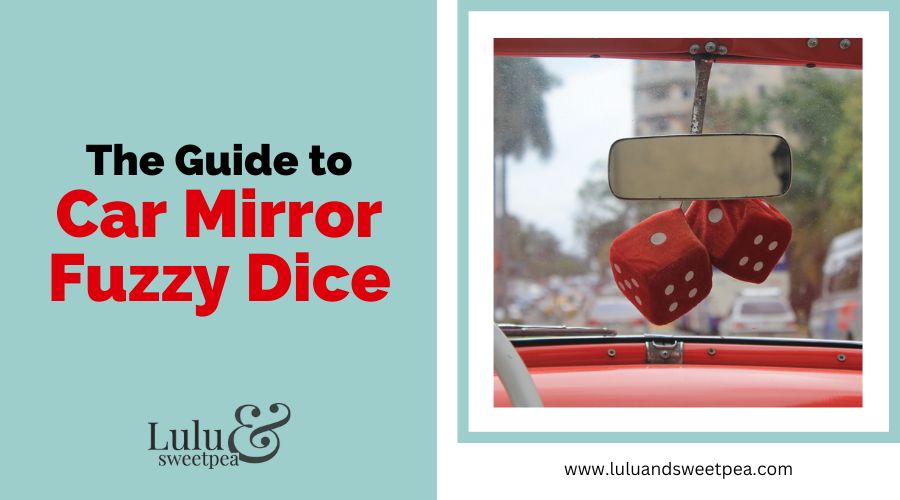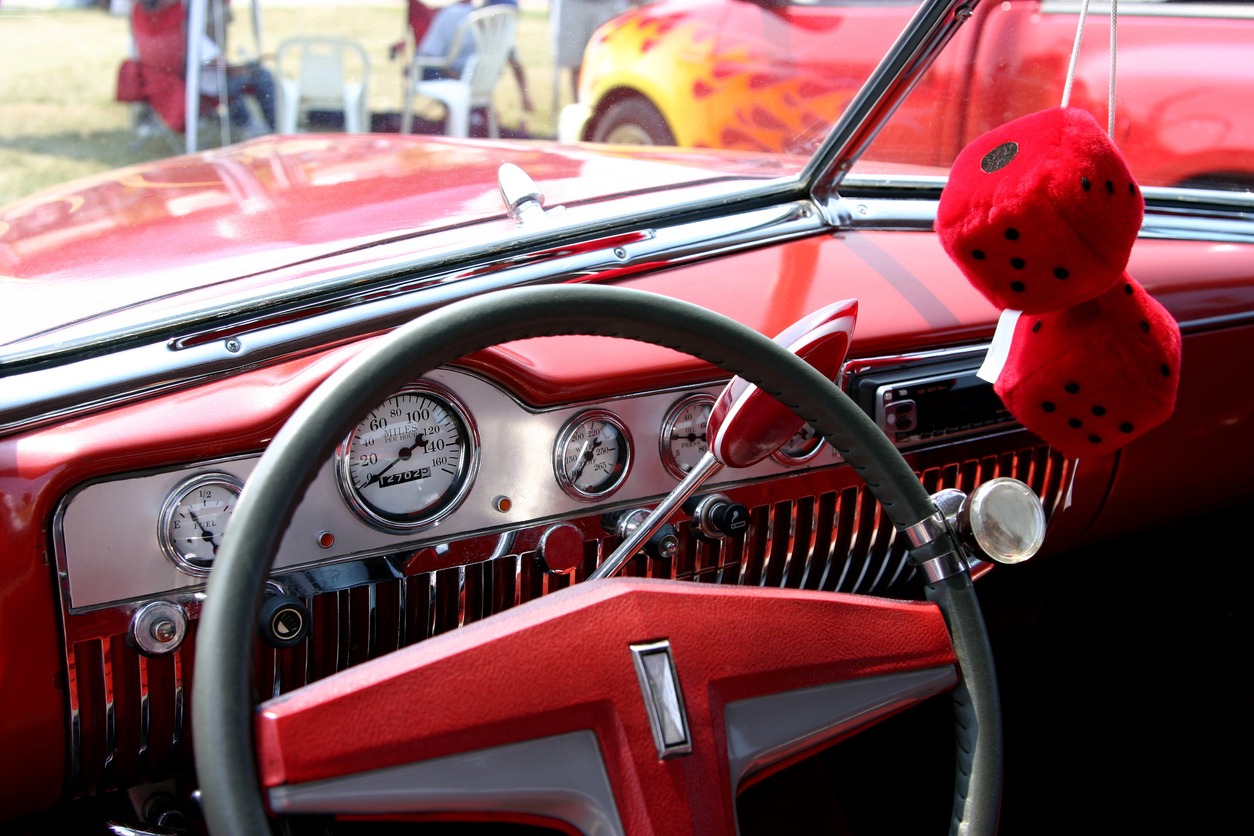If you’ve ever been a passenger or a driver in someone else’s car, you may have seen various decorations on the dashboard or dangling from the rearview mirror. As many individuals drive vehicles that are the same color, one of the few ways they may set theirs out from others is by adorning their dashboards with various gadgets and accessories. For accessory fans, the fuzzy dice are one of the most well-liked car decorations.
Many car owners have hung fuzzy dice on their beloved vehicles since the 1960s, but why did the accessory become popular and why is it still widely available in accessory shops and department stores today? Let’s explore the history of the car mirror fuzzy dice and see how it came to be one of the most recognizable automotive accessories in history to find the answers to these questions.
History
Fuzzy dice have their roots in American fighter pilots from World War II. Before a mission, fighter pilots would hang the dice above their instruments as luck and personality symbols. Many also think that the dice represented how perilous the expedition was, however, this has never been proven.
But in the 1950s, when the war was over, fuzzy dice became widely available, and many drivers chose to hang them on their rear-view mirrors. In the 1940s and 1950s, a set of fuzzy dice hanging from the rearview mirror was a requirement for any serious hot rod owner. Fuzzy dice are now a representation of retro style or humorous schlock.
World War II
According to traditional stories, pilots had a superstitious practice of placing a pair of dice on their instrument panel with seven pips visible before taking off for a sortie. The dice on the panel were a reminder that every trip was a metaphorical “roll of the dice” as to whether the jet would return safely to base, according to another, possibly grimmer version of the story. Pilots had a right to be pessimistic about their chances given that the United States was losing an average of 170 aircraft per day by 1942. Only the lucky victors were able to return home because every trip was a gamble.
Home Front
When World War II warriors returned home, they discovered a country in ruins. An entire generation of young men and women had been wrenched from their pleasant, typically rural, homes by the turmoil of conflict and wartime deprivation. Young people had two things they didn’t have before the war: freedom and money to spend. Many people channeled their agitation into a “need for speed”, and the golden age of the street rod blossomed.
A hot rod was a wonderful outlet for the mechanical skills that many veterans had learned in the service, and it could replace the adrenaline rush that many missed from their war days. In many places, an illegal street racing subculture arose.
Street Racing Culture
Nobody knows who was the first to hang a pair of plastic dice over his rearview mirror, echoing the superstition and cynicism of the early pilots. Plastic dice, like a pack of Lucky Strikes folded up in a t-shirt sleeve, soon became part of a look that distinguished the alternative society. Displaying the dice indicated that the driver was prepared and willing to gamble with death in the risky and unregulated realm of street racing.
Even the most stylish hot rods had to be functional. The cheap plastic dice melted in the heat of the sun, and they were quickly replaced by filled fuzzy dice. They were known as fluffy dice or furry dice in the United Kingdom.
The Fuzzy Dice Today
The tacky dice remained a part of car culture until the 1980s when racing became an organized sport. Drivers chose colors that suited their custom cars, and the dice became a statement of individualism rather than disobedience. However, by the end of the 1980s, more than one state had forbidden hanging anything from rearview mirrors, and the fad had become a cliché in general.
The practice has become so common that 1993 research discovered that drivers wearing fuzzy dice on their mirrors were no more likely to take risks or be involved in accidents than the ordinary motorist. However, when a new generation discovers vintage fads and fashions, symbols such as fuzzy dice are resurfacing. If you glance around the supermarket parking lot, you will most likely see a set dangling from a modified pickup and a regular minivan. They are now a symbol of nostalgia rather than revolt and recklessness.
Guide to Buying Your Fuzzy Dice
When you ride in someone else’s automobile, you may see various decorative elements on the dashboard, affixed to doors, or hanging from the rear-view mirror. Because most automobiles are the same colors (black, white, red, silver, and blue), you may make yours stand out by customizing it uniquely. Fuzzy dice, which have their origins in World War II, are still a popular way to decorate the interior of your car. Many individuals still hang them on their rearview mirrors as a decorative element.
Size
Because you’ll be hanging your fuzzy dice on the rear-view mirror, you’ll want to be sure they don’t hinder your view while driving. They shouldn’t be too little to be noticed, nor should they be so large that they take up too much space in your automobile.
Color
The choice of color could make or break the deal for you. The wrong hue of fuzzy dice will look hideous and be a complete financial waste. Decide if you want to break up the repetitive tone with vivid color or match the fuzzy color to the interior décor of your automobile. Additionally, choose a color that will be pleasing to look at while you’re stopped in traffic but won’t divert your focus when you’re driving.
The Style
Before buying fuzzy dice, consider your intended use: hanging them for good luck, displaying your bold side, invoking nostalgia for the 1950s and 1960s, or simply as a decorative item. If you are unsure about your intentions, go with a throwback design in a lucky, vibrant color and a decorative piece with a nod to the classic design.
Through the 1980s, fuzzy dice remained popular as the “it” accessory on rides. As people chose the dice’s colors to match their cars, they began to represent individualism rather than rebellion. But fuzzy dice started to seem corny from the 1990s to the present. Some people choose to stand out from the crowd, though, and boldly exhibit their fuzzy dice.
References:
[1] Story Behind Fuzzy Dice from
https://m.roadkillcustoms.com/story-behind-fuzzy-dice/
[2] The Story of Fuzzy Dice from
https://blog.hgregoire.com/en/the-history-of-fuzzy-dice
[3] History of Fuzzy Dice from
https://www.liveabout.com/history-of-fuzzy-dice-527558

